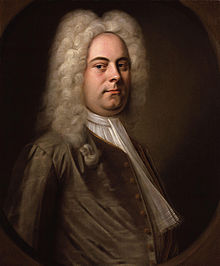- La resurrezione
-
"Resurrezione" redirects here. For films of this name, see Resurrection (film).
La resurrezione (HWV 47) is a sacred oratorio by George Frideric Handel, set to a libretto by Carlo Sigismondo Capece (1652–1728). Capece was court poet to Queen Maria Casimira of Poland, who was living in exile in Rome. It was first performed on the Easter Sunday of 1708 at Rome, with the backing of the Marchese Francesco Ruspoli, Handel's patron at this time. The work details the events between - and during - Good Friday and Easter Sunday, with the action carried forward in recitative, and exploration of character and delineation of mood taking place in the arias. The characters of the liturgical drama that appear in the oratorio are Lucifer (bass), Mary Magdalene (soprano), an Angel (soprano), St John the Evangelist (tenor), and St Mary Cleophas (alto).
Contents
First performance
A large orchestra was employed for the occasion, consisting of 39 strings of varying types, 1 bass viol, 2 trumpets, 1 trombone, and 4 oboes. The staging and scenery were also lavishly produced, and though Roman censorship of the time forbade opera, La resurrezione was certainly produced in an operatic manner. It was produced at Ruspoli's Palazzo in the main hall on the ground floor. A series of terraced seats, 4 in number, was built for the orchestra, curved towards the audience and rising at the back. Twenty-eight specially commissioned music stands were built for the occasion, engraved with either the coat-of-arms of Ruspoli or his wife. The proscenium was decorated with a tapestry depicting cherubs, palm trees, and foliage: in the middle of which hung a plaque with the name of the oratorio. The 46 letters were spread out over 4 lines, each letter about 18 cm in height. These letters were brought into prominence by the backing light of seventy light pans. The canvas backdrop represented pictorially the characters of Handel's oratorio, and in the centre was depicted the resurrection itself.
The role of Mary Magdalene was sung at the first performance by the soprano Margherita Durastanti. The participation of female singers was prohibited by Papal edict, and the Pope went to the length of admonishing Ruspoli for permitting Durastanti to take part. For the remaining performances, her role was sung by a castrato. The only details given concerning this individual are that he was called "Pippo", and that he was in service to the former Queen Casimiri. Durastanti later sang the title role in Handel's Agrippina. The aria "Ho un non so che" , which she had sung as Mary Magdalene anticipating the resurrection, appears entirely unadapted for her to sing in Agrippina, though in a different context. The violins at the first performance of La resurrezione were led by the famous violinist Arcangelo Corelli (who also conducted the work).
Other catalogues of Handel's music have referred to the work as HG xxxix; and HHA i/3.[1]
Structure
Part Type Voice Name I Overture I Aria Angel Disserratevi, oh porte d'averno I Recitative Lucifer Qual in solita luce I Aria Lucifer Caddi è ver, ma nel cader I Recitative Angel, Lucifer Ma che veggio I Recitative Angel, Lucifer Chi sei I Aria Angel D'amor fu consiglio I Recitative Angel, Lucifer Ebben, questo tuo Nume I Aria Lucifer O' voi dell'Erebo I Recitative Mary Magdalene Notte funesta I Aria Mary Magdalene Ferma l'ali I Recitative Mary Magdalene, St Mary Cleophas Concedi o Magdalena I Recitative Mary Magdalene, St Mary Cleophas Ahi dolce mio Signore I Duet Mary Magdalene, St Mary Cleophas Dolci chiodi I Recitative St John, Mary Magdalene, St Mary Cleophas O Cleofe I Aria St John Così la tortorella talor piange I Recitative Mary Magdalene Se Maria dunque spera I Aria Mary Magdalene Ho un non so che nel cor I Recitative Angel Uscite pur I Finale All Il Nume vincitor trionfi II Overture II Recitative St John Di qual nuovi portenti II Aria St John Ecco il sol ch'esce dal mar II Recitative St John Ma ove Maria dimora II Aria Angel Risorga il mondo II Recitative Angel Di rabbia indarno freme II Duet Angel, Lucifer Misero! Ho pur udito? II Aria Lucifer Per celare il nuovo scorno II Recitative Angel Oh come cieco il tuo furor delira II Duet Angel, Lucifer Impedirlo saprò II Recitative Mary Magdalene, St Mary Cleophas Amica, troppo tardo II Aria Mary Magdalene Per me già di morire II Recitative Lucifer Ahi abborrito nome II Aria St Mary Cleophas Vedo il ciel II Recitative Mary Magdalene, Angel, St Mary Cleophas Cleofe, siam giunte al luogo II Aria Angel Se per colpa di donna II Recitative Mary Magdalene Mio Giesù, mio Signore II Aria Mary Magdalene Del cielo dolente II Recitative St Mary Cleophas Sì, sì cerchiamo pure II Aria St Mary Cleophas Augeletti, ruscelletti II Recitative St Mary Cleophas, St John Dove si frettolosi II Aria St John Caro figlio II Recitative Mary Magdalene, St Mary Cleophas, St John Cleofe, Giovanni, udite II Aria Mary Magdalene Se impassibile, immortale II Recitative Mary Magdalene, St Mary Cleophas, St John Sì, sì col redentore II Final All Diasi lode in cielo, in terra References
- Hogwood, Christopher. Handel (1988), Thames and Hudson, ISBN 0-500-27498-3.
- ^ Anthony Hicks. "Handel, George Frideric", The New Grove Dictionary of Music and Musicians, ed. S. Sadie and J. Tyrrell (London: Macmillan, 2001), x, 784.
E-book
Score of La Resurrezione (ed. Friedrich Chrysander, Leipzig 1878)
Bibliography
- R. Ewerhart : New Sources for Handel’s La Resurrezione, ML, xli (1960), 127–35
- E. Rosand : Handel Paints the Resurrection, Festa musicologica: Essays in Honor of George J. Buelow, ed. T.J. Mathiesen and B.V. Rivera (Stuyvesant, NY, 1995), 7–52
- A. Hicks : Handel’s Early Musical Development, PRMA, ciii (1976–7), 80–89
- D. Burrows, ed.: The Cambridge Companion to Handel (Cambridge, 1997)
Categories:- Oratorios by George Frideric Handel
Wikimedia Foundation. 2010.

